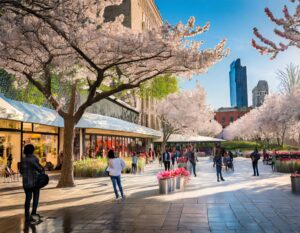In Washington, D.C., the retail market as of the second half of 2023 is characterized by a landlord-favored scenario, with both vacancy and availability at their lowest in three years. Despite initial fears of empty offices and a looming recession, consumer resilience has allowed landlords to exert substantial pricing leverage. Asking rents in the metro area have risen by 4% year-over-year, the highest increase in over 15 years. This growth is particularly notable in suburban areas like Prince George’s County and Northern Virginia, benefiting from population and income gains. The District’s Northeast and Southeast areas thrive due to residential growth and a shift towards food, nightlife, and experiential retail sectors.
Conversely, the rest of D.C. needs to improve, with most district submarkets falling in the metro’s bottom quartile for rent growth. The Central Business District and East End face potential increases in availability and longer vacancies due to reduced office attendance and recent crime incidents. Capital market activities have slowed, with sales volume decreasing significantly in recent quarters due to higher interest rates and regional lending constraints, reflecting a cautious investment climate.
Page Contents
- Suburban Strength in D.C.’s Retail Market
- Urban Retail Landscape: Mixed Fortunes
- Continued Rent Growth in D.C. Retail Market
- Suburban Advantages and Georgetown’s Revival
- Rising Demand for Retail Development in the D.C. Area
- Focus on Suburban Maryland and Northern Virginia
- Investment Slowdown in D.C.’s Retail Market
- Suburban Retail Centers and Successful Redevelopments
- Closing Thoughts
 Suburban Strength in D.C.’s Retail Market
Suburban Strength in D.C.’s Retail Market
In the first half of 2023, Washington, D.C.’s retail market remains robust, especially in suburban areas, showing resilience and recovery from the pandemic’s impact. Leasing activity has been stable, with around 1.2 million square feet of deals in Q2 of 2023, predominantly outside the District of Columbia. This trend is highlighted by significant leases like Kohl’s 87,000-square-foot deal at Stafford Marketplace, pushing the center’s occupancy to 99%. The deals further indicate a resurgence in suburban leasing, with significant deals primarily in Northern Virginia and Maryland, such as Burlington’s lease at Springfield Town Center and Bob’s Discount Furniture’s expansion in Bowie. These developments underscore a strong suburban retail sector, contrasting with the more varied urban market.
Urban Retail Landscape: Mixed Fortunes
Washington D.C.’s urban retail areas present a contrasting scenario. Despite fluctuating vacancy rates, as shown by Citibank’s recent lease, Georgetown remains a draw for high-end retail and tourists. Meanwhile, areas like the Southwest Waterfront and Union Market continue to attract retailers, driven by growth in multifamily and mixed-use developments. However, traditional office areas like the West End and Central Business District face challenges, marked by numerous vacant storefronts. The East End, notably Gallery Place, epitomizes these struggles with a high vacancy rate and potential closures looming, reflecting a divergent retail landscape within the city. This contrast highlights the differences between the thriving suburban retail market and the more complex urban retail environment in D.C.
Continued Rent Growth in D.C. Retail Market
As the second half of 2023 began, Washington, D.C.’s retail market experienced its strongest rent growth in two decades. With limited Class A space and a notably light development pipeline, property owners are in a favorable position in most negotiations. Retail rents in the metro area have reached record levels, averaging $32.00 per square foot (SF) NNN, reflecting a 3.7% increase over the past year. Despite these gains, D.C.’s growth rate lags behind the national average across all retail subtypes. Over the past five years, asking rents in D.C. have cumulatively increased by 12.0% and 26.6% over the past decade. These figures, while positive, are not considered exceptional in the context of the Washington metro retail market’s historical performance.
Suburban Advantages and Georgetown’s Revival
Contrasts are evident in different parts of the D.C. retail market. In Georgetown, despite initially doubling in vacancy post-COVID-19, high-demand addresses are commanding rents upwards of $150/SF NNN, making it the most expensive submarket in the area. This suggests a strong comeback in one of the city’s prime retail locations. Meanwhile, D.C.’s suburbs observe more significant rent increases, as tighter vacancy and the increased presence of office workers, owing to hybrid work models, boost demand. As of the third quarter of 2023, the top 25 submarkets for asking rent gains were all suburban, highlighting these areas’ growing appeal and strength. Prince George’s County, in particular, is witnessing increased retail demand driven by population and job growth, further emphasizing the suburban shift in the retail market dynamics.
Rising Demand for Retail Development in the D.C. Area
Retail tenant representatives are pressing for more development in Washington, D.C., a highly sought-after metro area for retailers. Midway through 2023, the region has seen less than 300,000 square feet of new retail space, indicating a trend toward the lightest year of retail supply in over 15 years. This follows a year of negative net deliveries. The current construction volume is significantly lower than in the past three years, reflecting a cautious approach from regional banks towards commercial real estate lending.
Focus on Suburban Maryland and Northern Virginia
Developer interest is particularly strong in suburban Maryland and Northern Virginia. In Maryland, Frederick’s Lake Linganore Town Center is a key development, with 200,000 square feet and 50% preleased by the end of Q2 2023. Another prominent project is The Aster at College Park, which integrates residential units with retail space, showcasing the trend towards mixed-use developments. Prince George’s County, while less publicized, is actively pursuing economic development, leveraging its transit assets to attract federal entities and tech companies. Northern Virginia also sees significant retail construction, especially in large mixed-use projects like Virginia Tech’s new campus at Alexandria’s Potomac Yard and Reston’s Halley Rise and Reston Station. These projects exemplify the shift towards mixed-use, transit-oriented developments, highlighting the region’s focus on integrating retail spaces within broader community infrastructures.
Investment Slowdown in D.C.’s Retail Market
In the second quarter of 2023, Washington D.C.’s retail market experienced a downturn in investment, attributed to high borrowing costs and reduced lending capacity. The metro area is on track for its lowest transaction year in nearly 15 years, with sales volume dropping to levels not seen since 2020. Despite this slowdown, brokers and bankers have a general consensus that the market’s solid demographics and tight space conditions will lead to a recovery once capital market conditions improve. However, the rapid decline in regional lending throughout 2023 has created significant headwinds, slowing down what was an unprecedented investment stretch in the area. Sales volume in the first quarter of 2023 was approximately $380 million, marking the first time since early 2021 that it fell below $400 million, with projections for the second quarter likely to be even lower.
 Suburban Retail Centers and Successful Redevelopments
Suburban Retail Centers and Successful Redevelopments
Despite the broader market challenges, suburban retail centers near high-income areas maintain pricing leverage due to tight vacancies and limited new construction, coupled with expanding residential development in Northern Virginia and Maryland suburbs. In the second quarter of 2023, CoStar reported several deals with capitalization rates (cap rates) between 5-6%, including a TD Bank standalone location in Annandale, Virginia, trading at a 4.88% cap rate, located in an area with a median household income of nearly $100,000. The Montgomery Village Center exemplifies successful redevelopment, selling for $40.25 million at the beginning of 2023 following a comprehensive $20 million renovation. This renovation included facade rehabilitation, a roadway extension, and the addition of townhouse strips, resulting in 280 new residential units. Key tenants like Aldi, Starbucks, and 7-Eleven, along with a mix of chain and local restaurants and service providers, have been instrumental in revitalizing the center.
Closing Thoughts
In summary, the Washington D.C. retail market of 2023 presents a landscape of contrasts and evolving dynamics. While the market has seen significant challenges due to high borrowing costs and a slowdown in investments, there are strong resilience indicators, particularly in suburban areas. The sustained demand for retail development, combined with the strategic focus on mixed-use projects in Northern Virginia and Maryland, underscores the potential for growth and revitalization. Despite the current investment downturn, there remains optimism for a rebound driven by the region’s robust demographics and tight space conditions. Successful redevelopments and sustained interest in high-income suburban centers suggest underlying strengths in the market. For investors navigating this complex and shifting landscape, seeking expert guidance and insights is crucial. Lumicre is well-positioned to provide comprehensive support and strategic advice for your investment needs in the Washington, D.C., retail market. Contact Lumicre to explore the opportunities and navigate the challenges in this dynamic market.